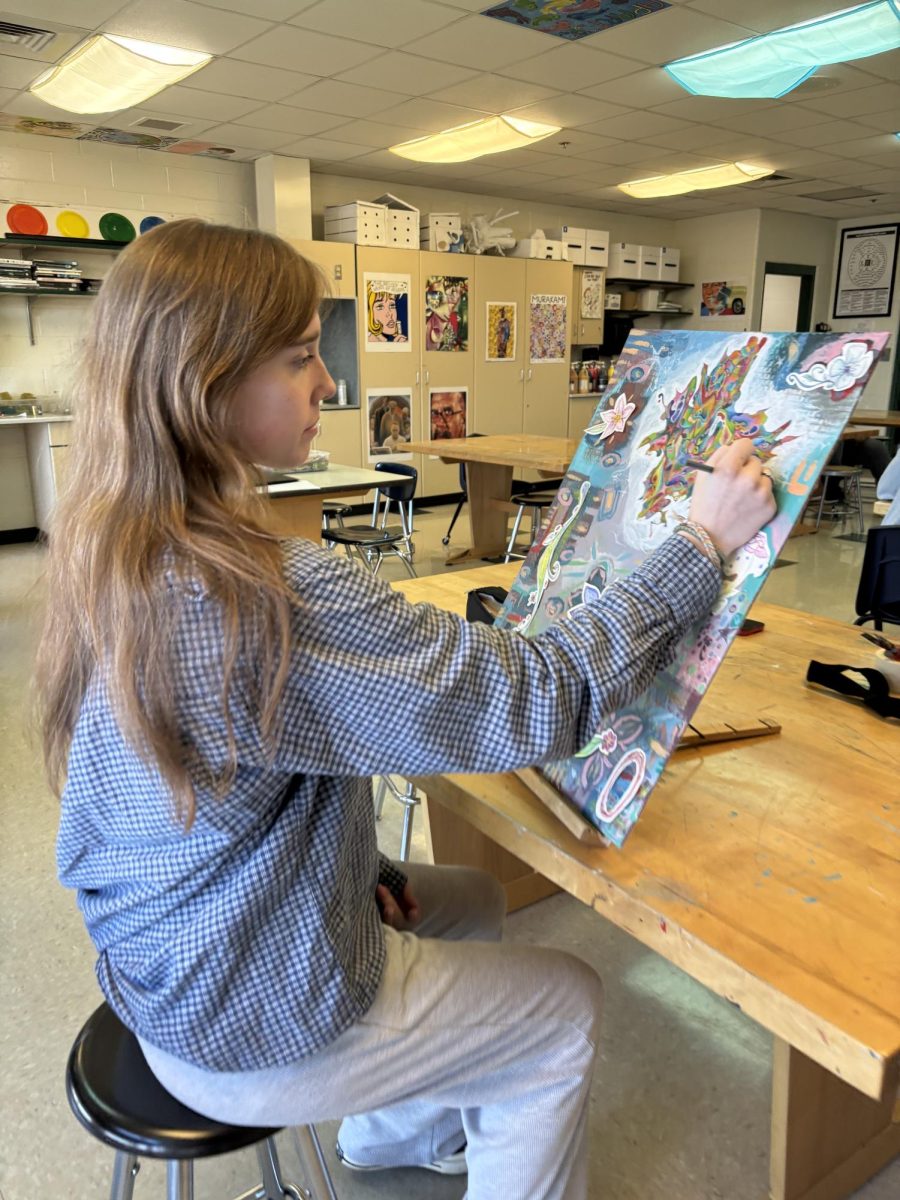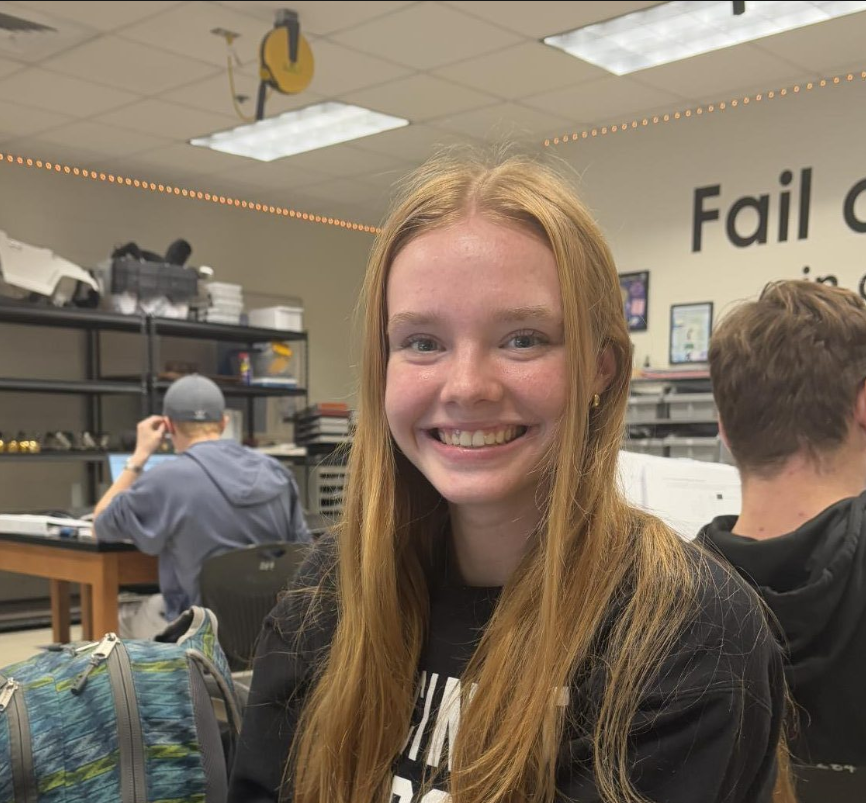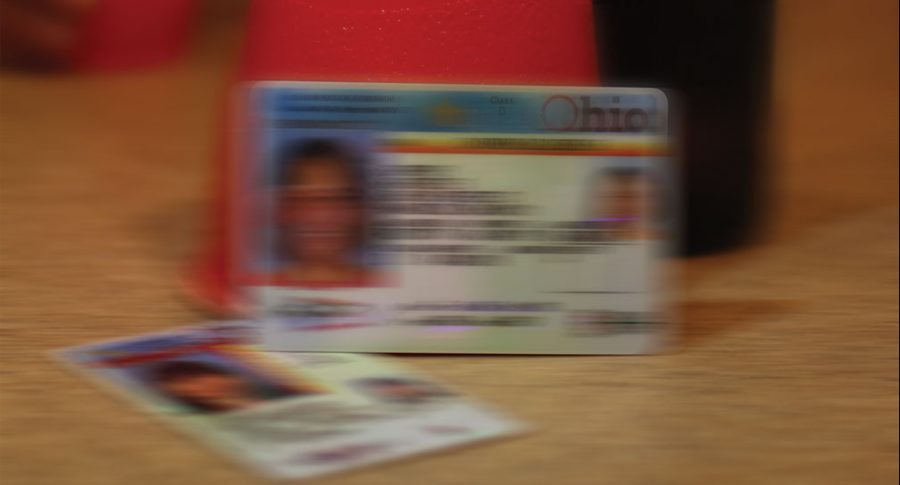Story by Sophia Spivey | Photo Illustration by Maya Wells
He walks into the bar his heart pounding in his chest. He clutches his fake ID tight in his clammy hand. Paranoid, he begins to wonder if anyone can tell he’s under 21. As his hands start to shake, he hesitantly gives his fake ID over to the bartender and asks for a whiskey on the rocks, attempting to convey he is old enough to order an alcoholic drink.
It is the first time that he has gotten alcohol without stealing it from his parents’ refrigerator. When the bartender casually hands back his fake ID with the alcohol in hand he knows that his mission was a success.
Lakota East alumni and University of Cincinnati (UC) junior Eric Jones, whose name has been changed, got his first fake ID when he was 19. His friends decided that they were going to order one, so he decided “why not.” The company his friends bought from charged $20 for each fake ID, so he decided to get two: that way if he lost one, he would have a backup.
During the month that Jones waited for his falsified license, he imagined what it would be like to buy alcohol from drug stores and bars with an ID that said he was 21. Usually when Lower went out drinking, he was not asked for his identification and was ecstatic to have a backup option on the way just in case the occasion arose.
“I haven’t even had to use [the ID] that much and, when I did, they either didn’t really care or couldn’t tell it was fake,” Jones said. “I’ve checked it with a real one from the same state and the only major difference is the font on the front.”
Of 78 East students surveyed, 45 percent said they know someone who has a fake ID, and 7.6 percent of 79 students surveyed said that they themselves have a fake ID.
According to The Ohio State University (OSU) Assistant Law Professor Micah Berman, having a fake ID is a criminal act in Ohio. It can lead to serious consequences for the owner of the ID such as jail time and a hefty fine with collateral damage including potential school sanctions and negative effects on a student’s academic career.
“Having or using a fake ID is against the law, and you shouldn’t do it,” Berman told Spark. “Most of my research focuses on tobacco policy and of course fake IDs are a problem in that area.”
Lakota West alumni and OSU freshman Jared Reynolds, whose name has been changed, was originally uncertain about buying a fake ID at 18, but eventually decided to buy one after he had time to think about it and a group of friends that already decided to purchase one.
“Getting alcohol in college isn’t exactly hard, so I got [the fake ID] more for the bar scene,” Reynolds said. “I figured there would be nights where friends would be going to bars instead of parties or whatever else was happening. I wanted to be able to join them and not miss out.”
According to a study conducted by the United States National Library of Medicine and the National Institutes of Health in 2007, 15 percent of high school students, 14 percent of college freshmen, and 24 percent of teenage drug abusers have purchased beer with a borrowed, altered or fake ID.
According to the Pennsylvania Liquor Control Board, nine out of 10 parents believe that teens would likely be able obtain alcohol using a fake ID, while only one-third of teens believe it would be that easy.
Oxford Police Department Detective Matthew Hatfield, who has been an officer for the past five years, knows exactly what to look for when it comes to teenagers concealing a fake ID since officers are trained to read body language when interacting with individuals. Majority of Hatfield’s exposures to fictitious IDs are related to underage drinking, since Oxford is a college town that includes Miami University.
Once the officer determines the ID is fictitious, there is probable cause for an arrest. I do not believe that an alcoholic beverage is worth risking one’s future. -Matthew Hatfield, Oxford Police Department Detective
“Officers are also trained on how to authenticate any form of ID, specifically driver’s licenses,” Hatfield said. “Once the officer determines the ID is fictitious, there is probable cause for an arrest. I do not believe that an alcoholic beverage is worth risking one’s future.”
Teenagers are able to purchase alcohol in approximately 30-50 percent of purchase attempts, either from commercial sources or social sources, according to the Pennsylvania Liquor Control Board.
According to East Principal Suzanna Davis, the school has high expectations for East students outside of school and said it is very disappointing when the community hears stories or has the belief that illegal activities, such as fake ID use, are a common occurrence. Davis told Spark that East does not have significant problems when it comes to fake IDs, but she is “not naive” to the fact that teenagers use fake IDs.
“It’s really not a school issue,” Davis said. “I don’t mean to minimize it, that it is not important, but it is not anything that we deal with at East in terms of the actual fake ID. Obviously we deal with students if they are inappropriately using substances in school, but in terms of fake IDs I don’t know if that is a dialogue that we have been involved in. It is very much focused in law enforcement and they deal with that.”
When fake ID users are caught, the prosecutor has two options to choose from when prosecuting. One option is the criminal code, which is a list of rule and regulations that defines conduct prohibited by the government because it threatens public safety and establishes punishment to be inflicted. The other option is the alcoholic beverage code, which is beverages that are illegally manufactured, distributed, bought, sold, processed, stored, possessed, imported or transported when prosecuting, according to the Purdue University website.
Federal law states that the possession or use of an altered driver’s license or state, federal or fake ID has the possibility of leading to a punishable fine of up to $25,000 and/or a five-year jail term.
According to Arenstein and Gallagher partner and Criminal Defense Attorney Bill Gallagher, not only does being caught with a fake ID have the potential to get the accused charged with up to 180 days in jail, probation time and a $1,000 fine, it can also result in the trouble when it comes to acceptance into college and consideration for jobs.
“Falsification is considered a crime of dishonesty,” Gallagher told Spark. “A college might reject an applicant as a result. Some colleges do inquire and search for issues of criminal behavior with applicants. A prospective employer might consider it a disqualifier for employment.”
Even with all of the legal regulations on alcohol sales to minors, 51% of underage college students reported that they considered alcohol “very easy” to obtain and 18% reported that they used false identification to obtain the liquor, according to the same study conducted by the United States National Library of Medicine and the National Institutes of Health already mentioned.
After some thought, Reynolds decided to get an out-of-state ID instead of an instate ID; that way bouncers, bartenders and officers would have a harder time telling that it is fake even though it is recognizably fictitious.
“People can tell it’s fake,” Reynolds said. “I have a Connecticut ID and [one time] someone laughed and said they love fakes from Connecticut since he was from Connecticut and he can easily tell. And I’m sure bouncers at the bar can tell, but most don’t really care. I’ve only seen a few [IDs] taken.”
If a UC student is found with a falsified license, the campus has a system in place that includes meeting with a hearing officer and discussing the student’s case, according to UC Program Coordinator in the Office of Student Conduct and Community Standards Rebecca Wallace. If the student is found responsible for having a fake ID, they would be found in violation of UC’s Student Code of Conduct’s policy on “Dishonesty and Misrepresentation.”
Wallace stands by the idea that if students have the right morals and role models in their lives, then they will consider standing by their values and making smart choices that will positively impact their future even in situations where external forces may be encouraging them not to.
“I believe in empowering our students to make decisions that are reflective of their values, abide by the standards of our community, including the law and help them reach the goals that they have set for the future,” Wallace said. “Given the legality and consequences of being found with a fake ID, I strongly question students’ decisions to have and use a fake ID.”
Hatfield is also concerned about the additional consequences a student can face on top of the criminal court case, such as a more difficult time receiving a job and disciplinary measures from their respective college.
“It is my understanding that if the individual arrested is a Miami University student, then Miami University would receive a copy of the arrest report from the city of Oxford,” Hatfield said. “This report is forwarded to Office of Student Conflict and Resolution for discipline consideration. Discipline through the school could potentially result in expulsion.”
According to Berman, using and possessing a fake ID is not the only illegal activity involving IDs. The spectrum of falsified IDs that a person can be charged for ranges far beyond that.
“It is also illegal to lend your ID to someone else for them to use,” Berman said. “If you use someone else’s ID, that can count as identity fraud, which is a separate, additional crime. And of course it is illegal to use a fake ID to purchase alcohol or tobacco.”
After looking at all of the legalities and scholarly consequences involved, Gallagher hopes that students, especially teenagers looking to go off to college, will think twice before putting their future in jeopardy over getting some alcohol.
“I personally view fake IDs as something many young people have,” Gallagher said. “They can lead to problems. People use them normally to be in places or do things the law has determined they are not mature enough to handle yet.”
In order to research for this story, writer Sophia Spivey attempted to buy a fake ID online with the cooperation of local police and recounted her experience.
This story originally appeared in the December issue of Spark.




































































































